boot SKODA ROOMSTER 2007 1.G User Guide
[x] Cancel search | Manufacturer: SKODA, Model Year: 2007, Model line: ROOMSTER, Model: SKODA ROOMSTER 2007 1.GPages: 248, PDF Size: 46.44 MB
Page 50 of 248
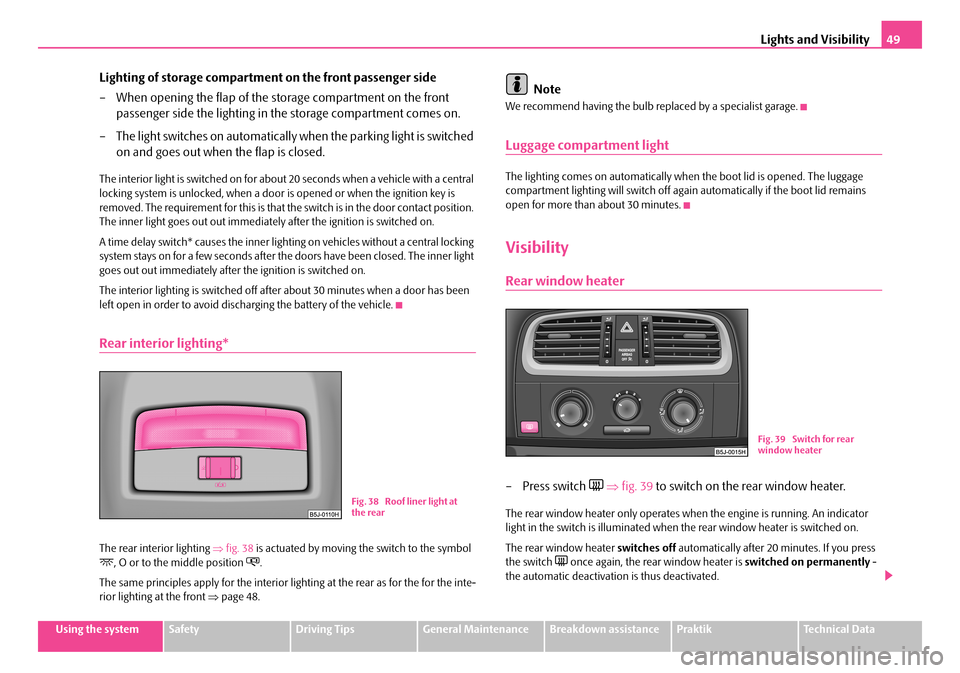
Lights and Visibility49
Using the systemSafetyDriving TipsGeneral MaintenanceBreakdown assistancePraktikTechnical Data
Lighting of storage compartment on the front passenger side
– When opening the flap of the storage compartment on the front
passenger side the lighting in the storage compartment comes on.
– The light switches on automatically when the parking light is switched
on and goes out when the flap is closed.
The interior light is switched on for abou t 20 seconds when a vehicle with a central locking system is unlocked, when a door is opened or when the ignition key is removed. The requirement for this is that the switch is in the door contact position. The inner light goes out out immediately after the ignition is switched on.
A time delay switch* causes the inner lighti ng on vehicles without a central locking system stays on for a few seconds after the doors have been closed. The inner light goes out out immediately after the ignition is switched on.
The interior lighting is switched off af ter about 30 minutes when a door has been left open in order to avoid discharging the battery of the vehicle.
Rear interior lighting*
The rear interior lighting ⇒fig. 38 is actuated by moving the switch to the symbol , O or to the middle position .
The same principles apply for the interior lighting at the rear as for the for the inte- rior lighting at the front ⇒page 48.
Note
We recommend having the bulb replaced by a specialist garage.
Luggage compartment light
The lighting comes on automatically when the boot lid is opened. The luggage compartment lighting will switch off again automatically if the boot lid remains open for more than about 30 minutes.
Visibility
Rear window heater
– Press switch ⇒fig. 39 to switch on the rear window heater.
The rear window heater only operates when the engine is running. An indicator light in the switch is illuminated when the rear window heater is switched on.
The rear window heater switches off automatically after 20 minutes. If you press the switch once again, the rear window heater is switched on permanently - the automatic deactivation is thus deactivated.
Fig. 38 Roof liner light at the rear
Fig. 39 Switch for rear window heater
NKO A05R 20 MR08.book Page 49 Wednesday, March 28, 2007 9:42 AM
Page 63 of 248
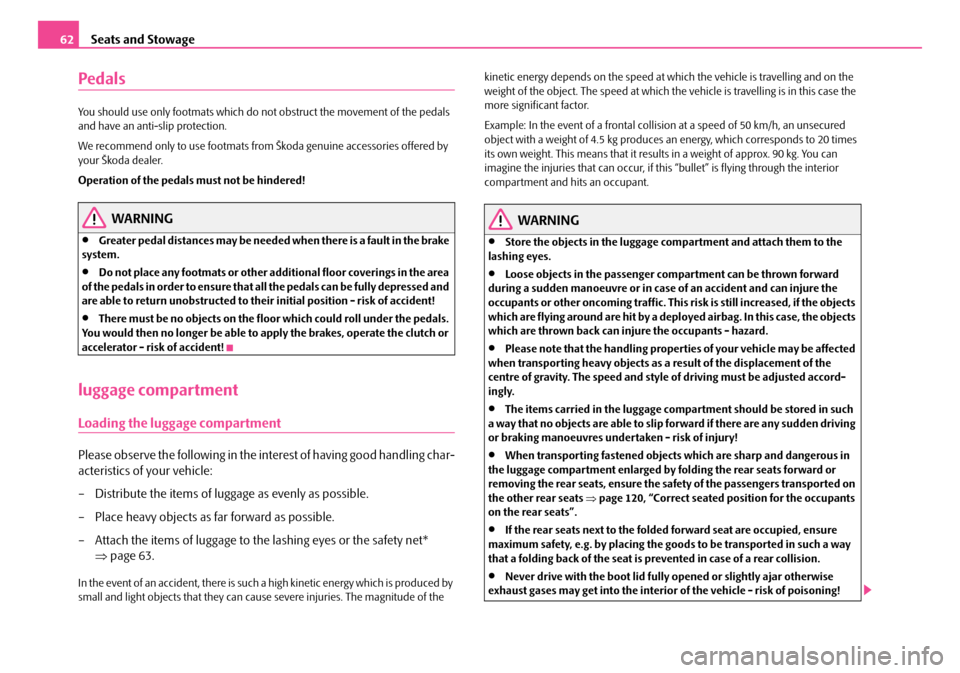
Seats and Stowage62
Pedals
You should use only footmats which do not obstruct the movement of the pedals and have an anti -slip protection.
We recommend only to use footmats from Škoda genuine accessories offered by your Škoda dealer.
Operation of the pedals must not be hindered!
WARNING
•Greater pedal distances may be needed when there is a fault in the brake system.
•Do not place any footmats or other additional floor coverings in the area of the pedals in order to ensure that all the pedals can be fully depressed and are able to return unobstructed to their initial position - risk of accident!
•There must be no objects on the floor which could roll under the pedals. You would then no longer be able to apply the brakes, operate the clutch or accelerator - risk of accident!
luggage compartment
Loading the luggage compartment
Please observe the following in the inte rest of having good handling char-
acteristics of your vehicle:
– Distribute the items of luggage as evenly as possible.
– Place heavy objects as far forward as possible.
– Attach the items of luggage to the lashing eyes or the safety net*
⇒ page 63.
In the event of an accident, there is such a high kinetic energy which is produced by small and light objects that they can caus e severe injuries. The magnitude of the
kinetic energy depends on the speed at which the vehicle is travelling and on the weight of the object. The speed at which the vehicle is travelling is in this case the more significant factor.
Example: In the event of a frontal collision at a speed of 50 km/h, an unsecured object with a weight of 4.5 kg produces an energy, which corresponds to 20 times its own weight. This means that it results in a weight of approx. 90 kg. You can imagine the injuries that can occur, if this “bullet” is flying through the interior compartment and hits an occupant.
WARNING
•Store the objects in the luggage compartment and attach them to the lashing eyes.
•Loose objects in the passenger compartment can be thrown forward during a sudden manoeuvre or in case of an accident and can injure the occupants or other oncoming traffic. This risk is still increased, if the objects which are flying around are hit by a depl oyed airbag. In this case, the objects which are thrown back can injure the occupants - hazard.
•Please note that the handling properti es of your vehicle may be affected when transporting heavy objects as a result of the displacement of the centre of gravity. The speed and style of driving must be adjusted accord- ingly.
•The items carried in the luggage compar tment should be stored in such a way that no objects are able to slip forward if there are any sudden driving or braking manoeuvres undertaken - risk of injury!
•When transporting fastened objects which are sharp and dangerous in the luggage compartment enlarged by folding the rear seats forward or removing the rear seats, ensure the safety of the passengers transported on the other rear seats ⇒page 120, “Correct seated position for the occupants on the rear seats”.
•If the rear seats next to the folded forward seat are occupied, ensure maximum safety, e.g. by placing the goods to be transported in such a way that a folding back of the seat is pr evented in case of a rear collision.
•Never drive with the boot lid fully opened or slightly ajar otherwise exhaust gases may get into the interior of the vehicle - risk of poisoning!
NKO A05R 20 MR08.book Page 62 Wednesday, March 28, 2007 9:42 AM
Page 66 of 248
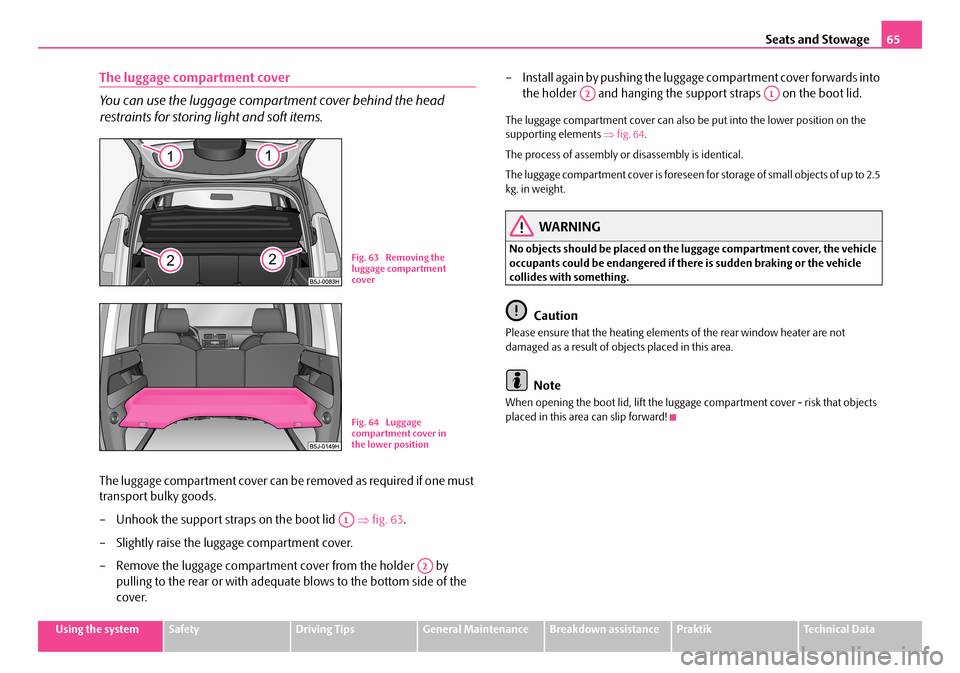
Seats and Stowage65
Using the systemSafetyDriving TipsGeneral MaintenanceBreakdown assistancePraktikTechnical Data
The luggage compartment cover
You can use the luggage compartment cover behind the head
restraints for storing light and soft items.
The luggage compartment cover can be removed as required if one must
transport bulky goods.
– Unhook the support stra ps on the boot lid ⇒fig. 63.
– Slightly raise the luggage compartment cover.
– Remove the luggage compartment cover from the holder by
pulling to the rear or with adequate blows to the bottom side of the
cover.
– Install again by pushing the luggage compartment cover forwards into
the holder and hanging the suppo rt straps on the boot lid.
The luggage compartment cover can also be put into the lower position on the supporting elements ⇒fig. 64.
The process of assembly or disassembly is identical.
The luggage compartment cover is foreseen fo r storage of small objects of up to 2.5 kg. in weight.
WARNING
No objects should be placed on the luggage compartment cover, the vehicle occupants could be endangered if th ere is sudden braking or the vehicle collides with something.
Caution
Please ensure that the heating elements of the rear window heater are not damaged as a result of obje cts placed in this area.
Note
When opening the boot lid, lift the luggage compartment cover - risk that objects placed in this area can slip forward!
Fig. 63 Removing the luggage compartment cover
Fig. 64 Luggage compartment cover in the lower position
A1
A2
A2A1
NKO A05R 20 MR08.book Page 65 Wednesday, March 28, 2007 9:42 AM
Page 69 of 248
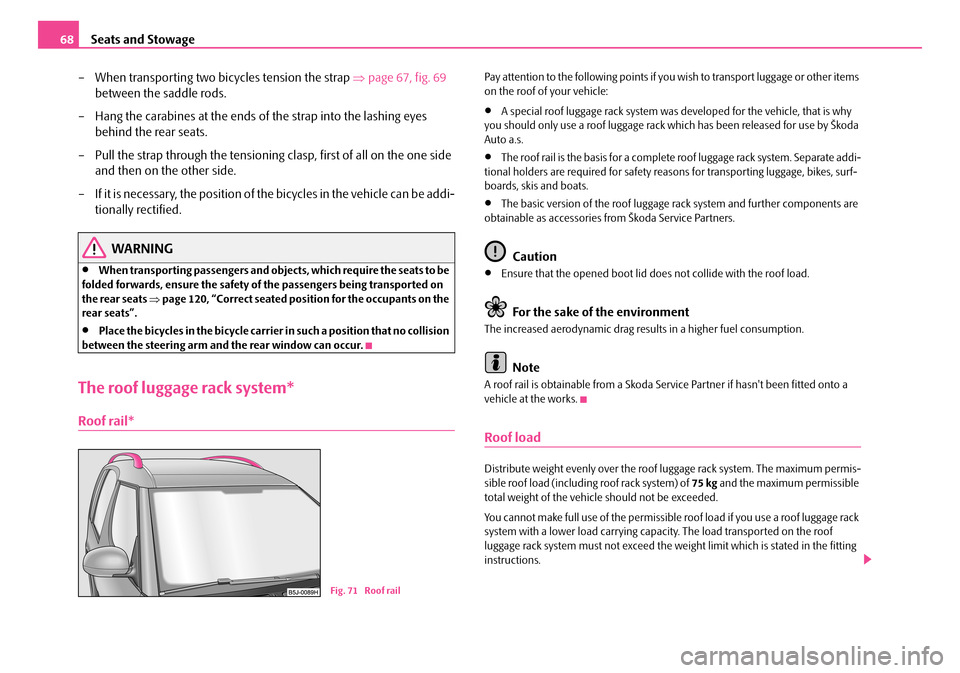
Seats and Stowage68
– When transporting two bicycles tension the strap ⇒page 67, fig. 69
between the saddle rods.
– Hang the carabines at the ends of the strap into the lashing eyes
behind the rear seats.
– Pull the strap through the tensioning clasp, first of all on the one side
and then on the other side.
– If it is necessary, the position of the bicycles in the vehicle can be addi-
tionally rectified.
WARNING
•When transporting passengers and obje cts, which require the seats to be folded forwards, ensure the safety of the passengers being transported on the rear seats ⇒page 120, “Correct seated position for the occupants on the rear seats”.
•Place the bicycles in the bicycle carrier in such a position that no collision between the steering arm and the rear window can occur.
The roof luggage rack system*
Roof rail*
Pay attention to the following points if you wish to transport luggage or other items on the roof of your vehicle:
•A special roof luggage rack system was developed for the vehicle, that is why you should only use a roof luggage rack which has been released for use by Škoda Auto a.s.
•The roof rail is the basis for a complete roof luggage rack system. Separate addi- tional holders are required for safety reasons for transporting luggage, bikes, surf-boards, skis and boats.
•The basic version of the roof luggage rack system and further components are obtainable as accessories from Škoda Service Partners.
Caution
•Ensure that the opened boot lid do es not collide with the roof load.
For the sake of the environment
The increased aerodynamic drag results in a higher fuel consumption.
Note
A roof rail is obtainable from a Skoda Service Partner if hasn't been fitted onto a vehicle at the works.
Roof load
Distribute weight evenly over the roof luggage rack system. The maximum permis- sible roof load (including roof rack system) of 75 kg and the maximum permissible total weight of the vehicle should not be exceeded.
You cannot make full use of the permissible roof load if you use a roof luggage rack system with a lower load carrying capa city. The load transported on the roof luggage rack system must not exceed the weight limit which is stated in the fitting instructions.
Fig. 71 Roof rail
NKO A05R 20 MR08.book Page 68 Wednesday, March 28, 2007 9:42 AM
Page 167 of 248
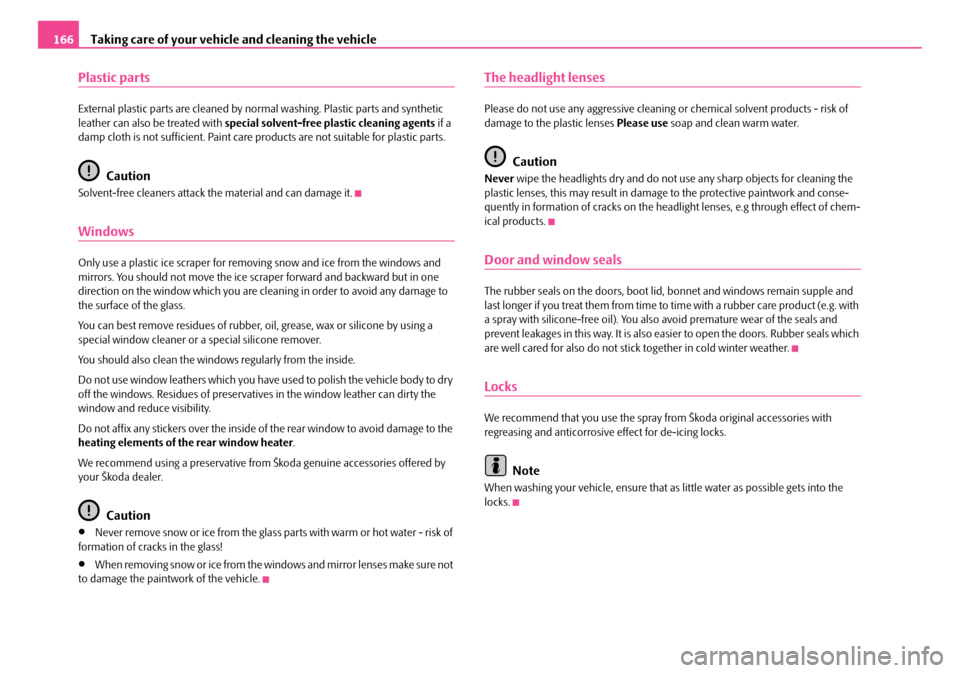
Taking care of your vehicle and cleaning the vehicle166
Plastic parts
External plastic parts are cleaned by normal washing. Plastic parts and synthetic leather can also be treated with special solvent-free plastic cleaning agents if a damp cloth is not sufficient. Paint care pr oducts are not suitable for plastic parts.
Caution
Solvent-free cleaners attack the material and can damage it.
Windows
Only use a plastic ice scraper for removing snow and ice from the windows and mirrors. You should not move the ice scraper forward and backward but in one direction on the window which you are clea ning in order to avoid any damage to the surface of the glass.
You can best remove residues of rubber, oil, grease, wax or silicone by using a special window cleaner or a special silicone remover.
You should also clean the windows regularly from the inside.
Do not use window leathers which you have used to polish the vehicle body to dry off the windows. Residues of preservati ves in the window leather can dirty the window and reduce visibility.
Do not affix any stickers over the inside of the rear window to avoid damage to the heating elements of the rear window heater .
We recommend using a preservative from Škoda genuine accessories offered by your Škoda dealer.
Caution
•Never remove snow or ice from the glass parts with warm or hot water - risk of formation of cracks in the glass!
•When removing snow or ice from the windows and mirror lenses make sure not to damage the paintwork of the vehicle.
The headlight lenses
Please do not use any aggres sive cleaning or chemical solvent products - risk of damage to the plastic lenses Please use soap and clean warm water.
Caution
Never wipe the headlights dry and do not use any sharp objects for cleaning the plastic lenses, this may result in damage to the protective paintwork and conse- quently in formation of cracks on the head light lenses, e.g through effect of chem- ical products.
Door and window seals
The rubber seals on the doors, boot lid, bonnet and windows remain supple and last longer if you treat them from time to time with a rubber care product (e.g. with a spray with silicone-free oil). You also avoid premature wear of the seals and prevent leakages in this way. It is also easier to open the doors. Rubber seals which are well cared for also do not stick together in cold winter weather.
Locks
We recommend that you use the spray from Škoda original accessories with regreasing and anticorrosive effect for de-icing locks.
Note
When washing your vehicle, ensure that as little water as possible gets into the locks.
NKO A05R 20 MR08.book Page 166 Wednesday, March 28, 2007 9:42 AM
Page 216 of 248
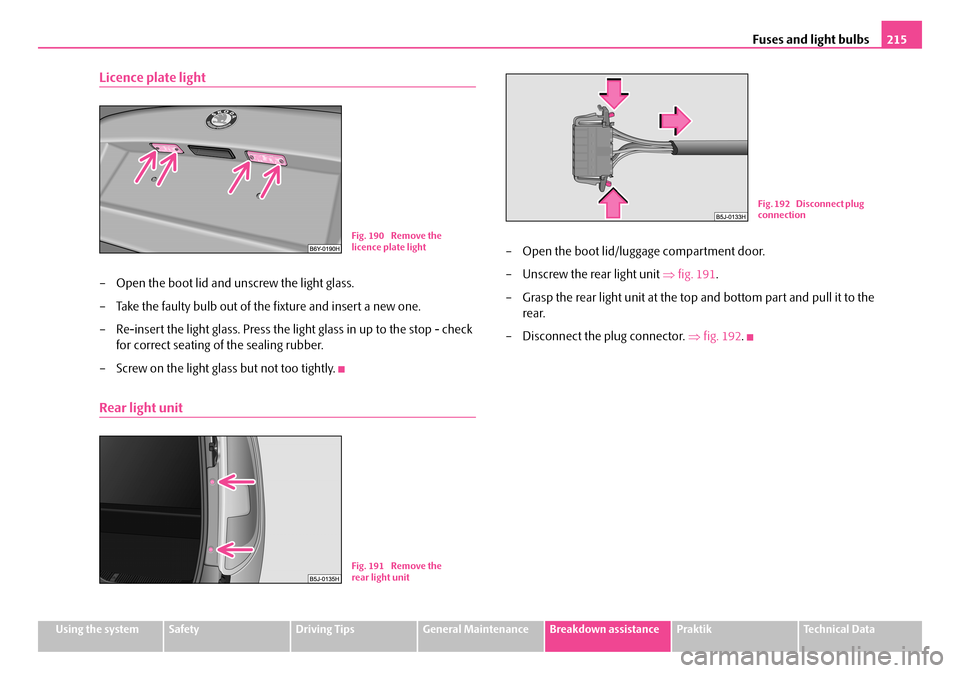
Fuses and light bulbs215
Using the systemSafetyDriving TipsGeneral MaintenanceBreakdown assistancePraktikTechnical Data
Licence plate light
– Open the boot lid and unscrew the light glass.
– Take the faulty bulb out of the fixture and insert a new one.
– Re-insert the light glass. Press the li ght glass in up to the stop - check
for correct seating of the sealing rubber.
– Screw on the light glass but not too tightly.
Rear light unit
– Open the boot lid/luggage compartment door.
– Unscrew the rear light unit ⇒fig. 191.
– Grasp the rear light unit at the top and bottom part and pull it to the
rear.
– Disconnect the plug connector. ⇒fig. 192.
Fig. 190 Remove the licence plate light
Fig. 191 Remove the rear light unit
Fig. 192 Disconnect plug connection
NKO A05R 20 MR08.book Page 215 Wednesday, March 28, 2007 9:42 AM
Page 217 of 248
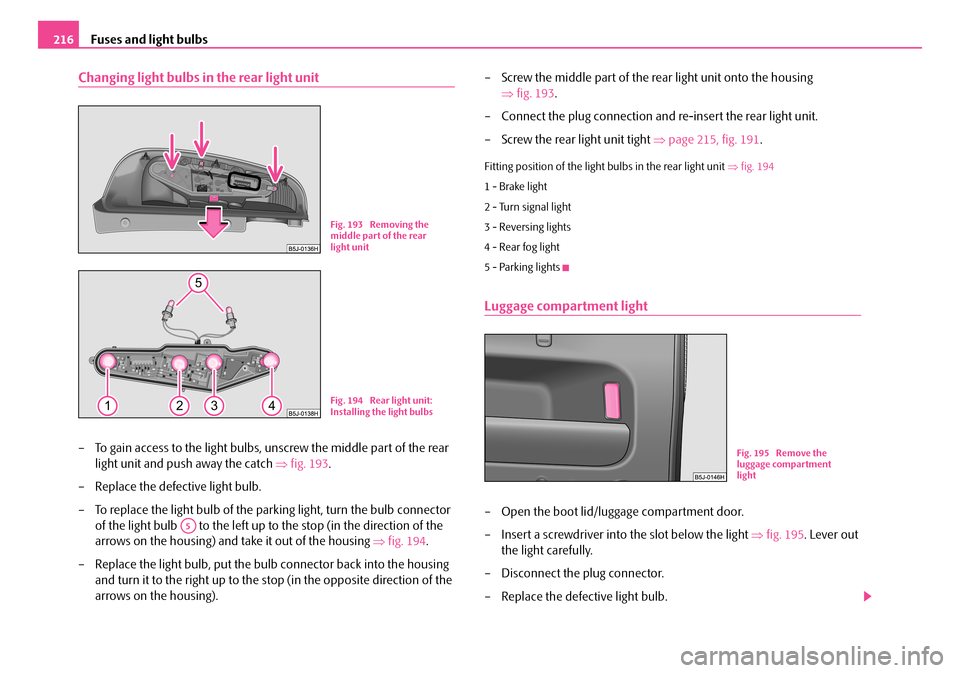
Fuses and light bulbs216
Changing light bulbs in the rear light unit
– To gain access to the light bulbs, unscrew the middle part of the rear
light unit and push away the catch ⇒fig. 193.
– Replace the defective light bulb.
– To replace the light bulb of the parking light, turn the bulb connector
of the light bulb to the left up to the stop (in the direction of the
arrows on the housing) and take it out of the housing ⇒fig. 194.
– Replace the light bulb, put the bulb connector back into the housing
and turn it to the right up to the stop (in the opposite direction of the
arrows on the housing).
– Screw the middle part of the rear light unit onto the housing
⇒ fig. 193.
– Connect the plug connection an d re-insert the rear light unit.
– Screw the rear light unit tight ⇒page 215, fig. 191.
Fitting position of the light bulbs in the rear light unit ⇒fig. 194
1 - Brake light
2 - Turn signal light
3 - Reversing lights
4 - Rear fog light
5 - Parking lights
Luggage compartment light
– Open the boot lid/luggage compartment door.
– Insert a screwdriver into the slot below the light ⇒fig. 195. Lever out
the light carefully.
– Disconnect the plug connector.
– Replace the defective light bulb.
Fig. 193 Removing the middle part of the rear light unit
Fig. 194 Rear light unit: Installing the light bulbs
A5
Fig. 195 Remove the luggage compartment light
NKO A05R 20 MR08.book Page 216 Wednesday, March 28, 2007 9:42 AM
Page 221 of 248
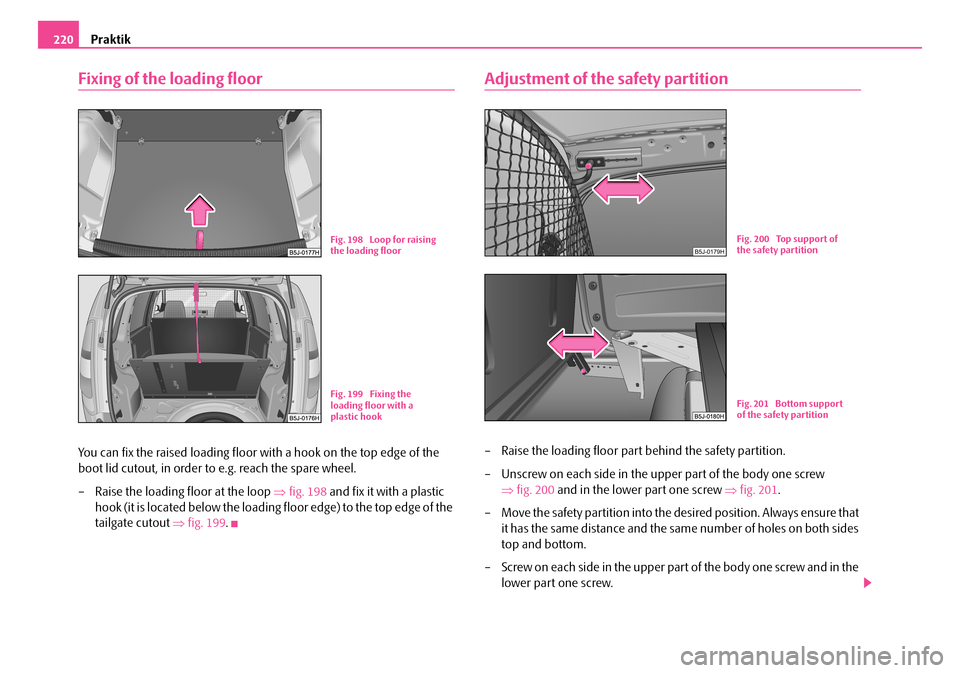
Praktik220
Fixing of the loading floor
You can fix the raised loading floor with a hook on the top edge of the
boot lid cutout, in order to e.g. reach the spare wheel.
– Raise the loading floor at the loop ⇒fig. 198 and fix it with a plastic
hook (it is located below the loading floor edge) to the top edge of the
tailgate cutout ⇒fig. 199.
Adjustment of the safety partition
– Raise the loading floor part behind the safety partition.
– Unscrew on each side in the upper part of the body one screw
⇒ fig. 200 and in the lower part one screw ⇒fig. 201.
– Move the safety partition into the de sired position. Always ensure that
it has the same distance and the same number of holes on both sides
top and bottom.
– Screw on each side in the upper part of the body one screw and in the
lower part one screw.
Fig. 198 Loop for raising the loading floor
Fig. 199 Fixing the loading floor with a plastic hook
Fig. 200 Top support of the safety partition
Fig. 201 Bottom support of the safety partition
NKO A05R 20 MR08.book Page 220 Wednesday, March 28, 2007 9:42 AM
Page 240 of 248
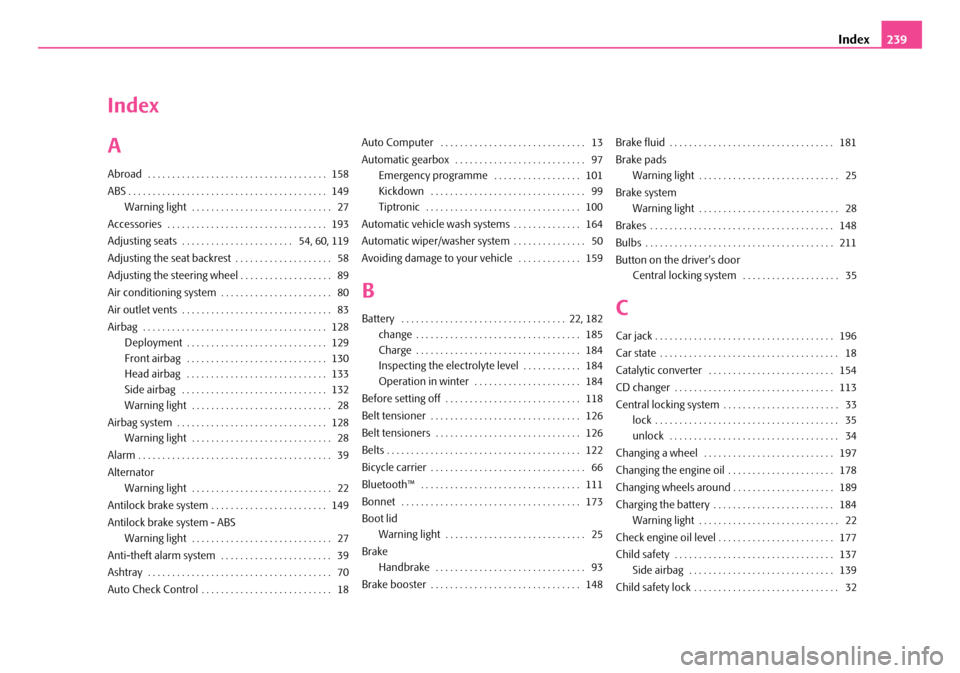
Index239
Index
A
Abroad . . . . . . . . . . . . . . . . . . . . . . . . . . . . . . . . . . . . . 158
ABS . . . . . . . . . . . . . . . . . . . . . . . . . . . . . . . . . . . . . . . . . 149
Warning light . . . . . . . . . . . . . . . . . . . . . . . . . . . . . 27
Accessories . . . . . . . . . . . . . . . . . . . . . . . . . . . . . . . . . 193
Adjusting seats . . . . . . . . . . . . . . . . . . . . . . . 54, 60, 119
Adjusting the seat backrest . . . . . . . . . . . . . . . . . . . . 58
Adjusting the steering wheel . . . . . . . . . . . . . . . . . . . 89
Air conditioning system . . . . . . . . . . . . . . . . . . . . . . . 80
Air outlet vents . . . . . . . . . . . . . . . . . . . . . . . . . . . . . . . 83
Airbag . . . . . . . . . . . . . . . . . . . . . . . . . . . . . . . . . . . . . . 128
Deployment . . . . . . . . . . . . . . . . . . . . . . . . . . . . . 129
Front airbag . . . . . . . . . . . . . . . . . . . . . . . . . . . . . 130
Head airbag . . . . . . . . . . . . . . . . . . . . . . . . . . . . . 133
Side airbag . . . . . . . . . . . . . . . . . . . . . . . . . . . . . . 132
Warning light . . . . . . . . . . . . . . . . . . . . . . . . . . . . . 28
Airbag system . . . . . . . . . . . . . . . . . . . . . . . . . . . . . . . 128
Warning light . . . . . . . . . . . . . . . . . . . . . . . . . . . . . 28
Alarm . . . . . . . . . . . . . . . . . . . . . . . . . . . . . . . . . . . . . . . . 39
Alternator
Warning light . . . . . . . . . . . . . . . . . . . . . . . . . . . . . 22
Antilock brake system . . . . . . . . . . . . . . . . . . . . . . . . 149
Antilock brake system - ABS
Warning light . . . . . . . . . . . . . . . . . . . . . . . . . . . . . 27
Anti-theft alarm system . . . . . . . . . . . . . . . . . . . . . . . 39
Ashtray . . . . . . . . . . . . . . . . . . . . . . . . . . . . . . . . . . . . . . 70
Auto Check Control . . . . . . . . . . . . . . . . . . . . . . . . . . . 18
Auto Computer . . . . . . . . . . . . . . . . . . . . . . . . . . . . . . 13
Automatic gearbox . . . . . . . . . . . . . . . . . . . . . . . . . . . 97
Emergency programme . . . . . . . . . . . . . . . . . . 101
Kickdown . . . . . . . . . . . . . . . . . . . . . . . . . . . . . . . . 99
Tiptronic . . . . . . . . . . . . . . . . . . . . . . . . . . . . . . . . 100
Automatic vehicle wash systems . . . . . . . . . . . . . . 164
Automatic wiper/washer system . . . . . . . . . . . . . . . 50
Avoiding damage to your vehicle . . . . . . . . . . . . . 159
B
Battery . . . . . . . . . . . . . . . . . . . . . . . . . . . . . . . . . . 22, 182
change . . . . . . . . . . . . . . . . . . . . . . . . . . . . . . . . . . 185
Charge . . . . . . . . . . . . . . . . . . . . . . . . . . . . . . . . . . 184
Inspecting the electrolyte level . . . . . . . . . . . . 184
Operation in winter . . . . . . . . . . . . . . . . . . . . . . 184
Before setting off . . . . . . . . . . . . . . . . . . . . . . . . . . . . 118
Belt tensioner . . . . . . . . . . . . . . . . . . . . . . . . . . . . . . . 126
Belt tensioners . . . . . . . . . . . . . . . . . . . . . . . . . . . . . . 126
Belts . . . . . . . . . . . . . . . . . . . . . . . . . . . . . . . . . . . . . . . . 122
Bicycle carrier . . . . . . . . . . . . . . . . . . . . . . . . . . . . . . . . 66
Bluetooth™ . . . . . . . . . . . . . . . . . . . . . . . . . . . . . . . . . 111
Bonnet . . . . . . . . . . . . . . . . . . . . . . . . . . . . . . . . . . . . . 173
Boot lid
Warning light . . . . . . . . . . . . . . . . . . . . . . . . . . . . . 25
Brake
Handbrake . . . . . . . . . . . . . . . . . . . . . . . . . . . . . . . 93
Brake booster . . . . . . . . . . . . . . . . . . . . . . . . . . . . . . . 148
Brake fluid . . . . . . . . . . . . . . . . . . . . . . . . . . . . . . . . . . 181
Brake pads
Warning light . . . . . . . . . . . . . . . . . . . . . . . . . . . . . 25
Brake system
Warning light . . . . . . . . . . . . . . . . . . . . . . . . . . . . . 28
Brakes . . . . . . . . . . . . . . . . . . . . . . . . . . . . . . . . . . . . . . 148
Bulbs . . . . . . . . . . . . . . . . . . . . . . . . . . . . . . . . . . . . . . . 211
Button on the driver's door
Central locking system . . . . . . . . . . . . . . . . . . . . 35
C
Car jack . . . . . . . . . . . . . . . . . . . . . . . . . . . . . . . . . . . . . 196
Car state . . . . . . . . . . . . . . . . . . . . . . . . . . . . . . . . . . . . . 18
Catalytic converter . . . . . . . . . . . . . . . . . . . . . . . . . . 154
CD changer . . . . . . . . . . . . . . . . . . . . . . . . . . . . . . . . . 113
Central locking system . . . . . . . . . . . . . . . . . . . . . . . . 33
lock . . . . . . . . . . . . . . . . . . . . . . . . . . . . . . . . . . . . . . 35
unlock . . . . . . . . . . . . . . . . . . . . . . . . . . . . . . . . . . . 34
Changing a wheel . . . . . . . . . . . . . . . . . . . . . . . . . . . 197
Changing the engine oil . . . . . . . . . . . . . . . . . . . . . . 178
Changing wheels around . . . . . . . . . . . . . . . . . . . . . 189
Charging the battery . . . . . . . . . . . . . . . . . . . . . . . . . 184
Warning light . . . . . . . . . . . . . . . . . . . . . . . . . . . . . 22
Check engine oil level . . . . . . . . . . . . . . . . . . . . . . . . 177
Child safety . . . . . . . . . . . . . . . . . . . . . . . . . . . . . . . . . 137
Side airbag . . . . . . . . . . . . . . . . . . . . . . . . . . . . . . 139
Child safety lock . . . . . . . . . . . . . . . . . . . . . . . . . . . . . . 32
NKO A05R 20 MR08.book Page 239 Wednesday, March 28, 2007 9:42 AM